A well-functioning engine depends on more than robust pistons and precise timing—it relies on a clean, efficient crankcase ventilation system. The valve cover oil separator plays a crucial role in this process by capturing oil mist and blow-by gases before they re-enter the intake. Upgrading or replacing your worn separator not only protects turbochargers and intercoolers from oily deposits but also improves throttle response and overall engine longevity. Below, you’ll find an in-depth look at what a valve cover oil separator does, why it matters, how to select the right unit, and step-by-step guidance for installing your new part.
What Is a Valve Cover Oil Separator?
During combustion, a small percentage of high-pressure gases escape past the piston rings into the crankcase—a phenomenon known as blow-by. These gases carry tiny oil droplets that, if left unchecked, accumulate in the intake tract, reducing efficiency and fouling sensors. A valve cover oil separator intercepts this mixture, causing oil droplets to coalesce and drain back into the crankcase, while rerouting clean gases into the intake manifold for reburning. Unlike simple PCV valves, modern oil separators often include multi-stage filtration media or centrifuge designs that achieve up to 99% oil removal, keeping your intake plumbing pristine.
Why Upgrade Your Oil Separator?
- Protect Turbochargers and Intercoolers
Oil contamination can coat turbine wheels and intercooler fins, degrading boost efficiency and increasing intake air temperatures. A high-performance valve cover oil separator prevents this oily buildup, preserving turbo response and reducing the risk of compressor surge. - Maintain Clean Intake Sensors
Mass airflow (MAF) and manifold absolute pressure (MAP) sensors rely on unobstructed airflow to deliver accurate readings. By trapping oil mist before it reaches these components, your engine control unit (ECU) can maintain precise fuel-air ratios. - Improve Throttle Response
Removing oil residue from the intake tract eliminates the sticky buildup that can slow airflow. The result is crisper throttle transitions and a more immediate engine response under load. - Extend Engine Life
Cleaner combustion translates to fewer deposits on intake valves, piston crowns, and cylinder walls. Over time, this helps maintain compression and reduces the likelihood of knock or hot spots.
Key Features to Look for in a Valve Cover Oil Separator
When selecting an oil separator, consider the following attributes:
- Filtration Efficiency: Aim for a separator rated at 90–99% oil removal. Multi-stage filters combining mesh screens with coalescing fibers deliver superior results.
- Flow Capacity: Ensure the unit can handle your engine’s blow-by volume. Turbocharged or high-output engines generate more crankcase pressure and require larger separators.
- Material Durability: An anodized aluminum housing resists corrosion and heat, while high-quality silicone hoses withstand oil and temperature fluctuations.
- Ease of Service: Look for separators with removable cartridges or clean-out ports to simplify periodic maintenance without disassembly.
- Sealing and Fittings: O-ring-sealed end caps and precision-machined inlet/outlet ports prevent leaks and ensure a tight fit.
Klifex’s valve cover oil separator 55596087 combines all these features in a drop-in package tailored for both performance enthusiasts and daily drivers.
Signs Your Separator Needs Replacement
Even high-quality separators eventually reach capacity or degrade. Watch for these indicators:
- Elevated Oil Consumption: A clogged separator can’t drain oil back into the crankcase, leading to higher oil use.
- Visible Oil in Intake Pipes: Remove an intake hose and inspect—glossy, oily residue signals separator failure.
- Rough Idle or Stalling: Excessive crankcase pressure can force oil past seals and gaskets, disrupting vacuum and idle stability.
- Check Engine Light (P0101/P0171): Erratic MAF readings from oil-fouled sensors may trigger diagnostic trouble codes.
If you observe one or more of these symptoms, fitting a new valve cover oil separator should be a priority.
Step-by-Step Installation Guide
- Gather Tools and Parts
You’ll need basic hand tools (ratchet, sockets, pliers), your new oil separator kit, a clean rag, and a small catch pan for residual oil. - Relieve Crankcase Pressure
With the engine off and cool, remove the PCV valve hose from the separator to release trapped pressure safely. - Remove the Old Separator
Loosen hose clamps and disconnect vacuum and breather hoses from the housing. Unbolt or unclip the separator from its mounting bracket. - Inspect Hoses and Fittings
Examine silicone hoses and barbed fittings for cracks or wear. Replace any brittle lines to ensure a leak-free system. - Install the New Separator
Mount your Klifex valve cover oil separator in the factory location or specified bracket. Ensure the housing is oriented correctly for drain-back flow. - Reconnect Hoses
Attach breather and PCV hoses to the designated ports. Use new hose clamps to secure each connection snugly. - Prime the Separator
If your kit includes a cartridge, lightly coat the filter media with engine oil to improve initial seal-in. - Start the Engine and Check for Leaks
Let the engine idle for a few minutes, then monitor all connections. Tighten any fittings if you spot oil seepage. - Road Test
Take a short drive under varying load conditions to ensure smooth operation and verify there are no vacuums leaks or odd noises.
Maintenance Tips for Long-Term Performance
- Periodic Inspection: Every 10,000 miles, remove and inspect the separator for oil buildup. Clean or replace filter elements as needed.
- Hose Replacement: Change silicone hoses every 2–3 years to avoid cracks that lead to vacuum leaks.
- Oil Quality: Running high-grade synthetic oil reduces sludge and prolongs filter life.
- Bracket and Mounting Check: Ensure mounting hardware remains tight to prevent vibration-induced wear.
Adhering to these practices will keep your valve cover oil separator operating at peak efficiency and protect downstream components.
Where to Purchase
For a precision-engineered solution that fits a wide range of engines, trust Klifex. Their Valve cover oil separator is crafted from billet aluminum, features replaceable filter media, and includes all necessary hoses and clamps. Backed by expert support and a satisfaction guarantee, this kit makes crankcase ventilation maintenance straightforward and effective.
Investing in a high-quality valve cover oil separator is a small step with big payoffs: cleaner intake tracts, more consistent sensor readings, and reduced wear on vital engine and turbocharger components. By following proper selection, installation, and maintenance guidelines, you’ll enjoy smoother performance and longer engine life. Order your Klifex kit today and breathe new life into your vehicle’s crankcase ventilation system.






